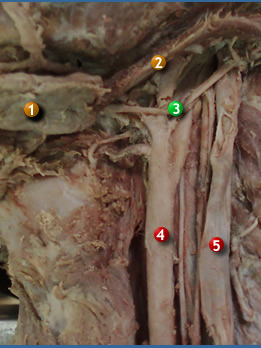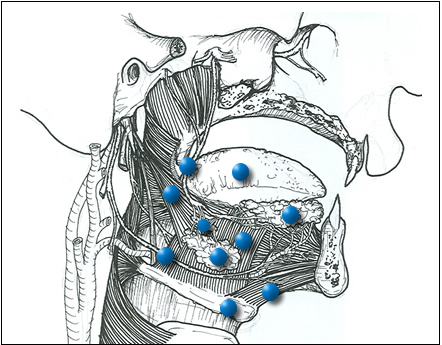24.4 Submandibular region |
| Introduction |
|
This region lies deep to the body of the mandible , and is also called the suprahyoid region.
|

|
Contents
The main contents in this region include:-
- submandibular and sublingual glands
- lingual nerve and vessels
- hypoglossal nerve
- submandibular ganglion
- suprahyoid muscles (digastric, stylohyoid, mylohyoid and geniohyoid)

|
|
| submandibular gland |
 |
Consists of a large superficial part and a small deep part which are Continous with one another around the free posterior margin of mylohyoid.
Position
- Deep to and extending below body of mandible
- Found in submandibular triangle
- Extends to carotid triangle
- Between two bellies of digastric muscle
|
 |
|
|
| Surfaces and relations |
Superficial part has three surfaces:
Medial surface |
Inferior or superficial surface: |
Lateral Surface |
|
- Mylohyoid, and hyoglossus muscles,
- Lingual nerve,
- Hypoglossal nerve
- Facial artery
|
- Skin, Platysma, Investing fascia
- facial vein
- cervical and marginal mandibular branches of facial nerve
|
- Body of mandible
- Medial pterygoid
- Facial artery
- Masseter
|
| |
|
|
|
|
| The deep part extends forwards for a variable distance between the mylohyoid and hyoglosus, below the lingual nerve and above the hypoglossal nerve. |
|
| Submandibular duct of Wharton |
Course
- Emerges from the superficial part of the gland near the posterior border of mylohyoid.
- Runs with the deep part forwards and slightly upwards
- Between the mylohyoid and hyoglossus
- Between sublingual gland and genioglossus muscle~
- Lies on hyoglossus
- Crossed laterally by the lingual nerve
Termination
- Floor of the mouth on the sublingual papilla beside the frenulum of the tongue
|
|
| Blood supply |
|
- Submandibular branches of facial artery and corresponding veins
|
| Lymph drainage |
|
| Submandibular lymph nodes |
| Nerve supply |
|
 Parasympathetic Parasympathetic
- Preganglionic fibres superior salivary nucleus in the pons
- Nervous intermedius, chorda tympani and lingual nerve.
- Submandibular ganglion
- Postganglionic fibres are direct to the gland
 Sympathetic (vasoconstrictor) fibres come from the plexus around the facial artery. Sympathetic (vasoconstrictor) fibres come from the plexus around the facial artery.
 General sensory: Lingual nerve General sensory: Lingual nerve
|
|
| |
|
| Sublingual gland |
|
|
 |
Position
- In the submandibular region beneath the mucosa of the floor of the mouth
- Occupies the sublingual fova
- Above mylohyoid nerve
|
|
| |
|
Relations
| |
|
|
|
|
Superior:
|
Medial : |
Lateral |
Anterior |
Posterior |
|
|
- Genio glossus muscle
- Submandibular duct
- Lingual nerve
|
- Mandible
- Inferior
- Mylohyoid nerve
|
- Genioglossus muscle
- Its fellow
|
- Deep part of submandibular gland
|
| |
|
|
|
|
|
|
| Blood supply |
- Sublingual artery- lingual
- Submental artery- facial
- Veins correspond to the arteries
|
| Lymphatic drainage |
- Submandibular nodes
- Submental nodes
|
| Innervation |
See submandibular gland |
|
| |

